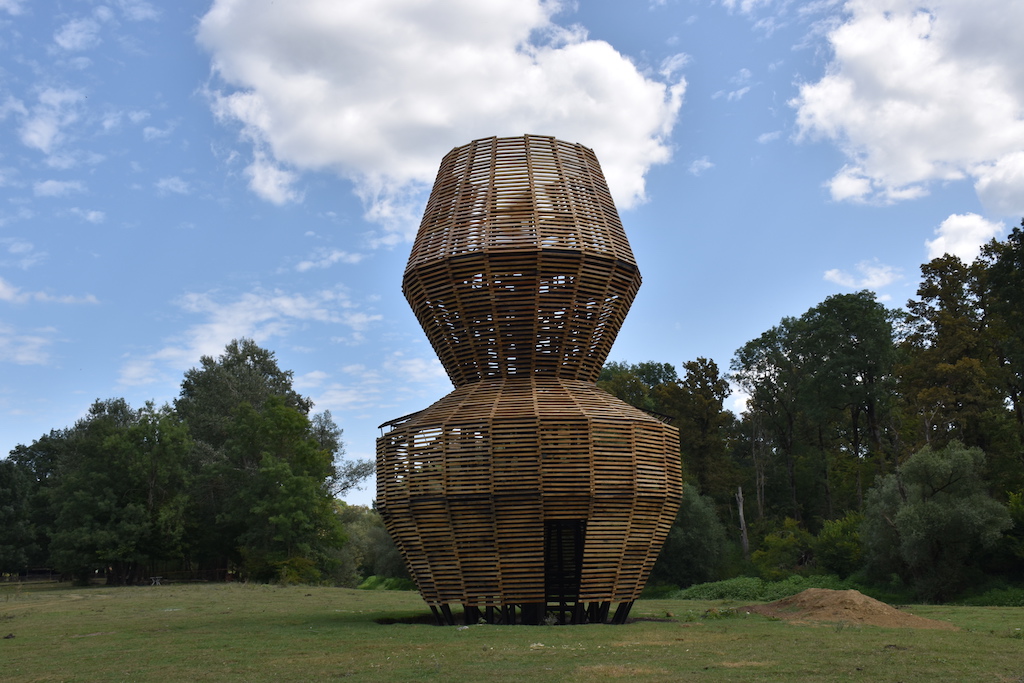Reducing CO2 in Croatia: Nestlé Plants Pedunculate Oak Forest at Lonjsko Polje Nature Park
April 6, 2022 - Nestlé has planted a pedunculate oak forest at Lonjsko Polje Nature Park and donated electric scooters to support more sustainable forms of transport.
Nestlé, the largest food company globally, donated 115 pedunculate oak seedlings and four electric scooters to the Lonjsko Polje Nature Park. The seedlings together form a natural small oak forest, and each of them represents one Nestlé employee in Croatia. Electric scooters support and remind the company of the importance of switching to more sustainable forms of transport.
"Nestlé is aware of its role in shaping the planet's more sustainable future. At all levels of the business, we invest significant resources to contribute to reducing waste, the use of disposable plastics, and the reduction of water pollution. As part of the #ChooseGreen initiative in Croatia, we are taking concrete steps towards sustainability. This year, in partnership with the Lonjsko Polje Nature Park, we have focused on reducing greenhouse gas emissions, which contribute to global warming," said Laurentiu-Florin Dimitriu, Nestlé CEO for Croatia, Slovenia, and Bosnia and Herzegovina.
According to experts from the O2 Project, pedunculate oak is essential for the entire animal world in Lonjsko polje and is a source of food for many organisms, from insects to deer. Many animals also found a home on the oak trunk. The bald eagle, one of the largest birds in Croatia, nests in tall oak canopies, while in rotten trunks or dead parts of the tree, we can often find larvae of the stag beetle. Just one pedunculate tree represents a small ecosystem, so we can only imagine what one forest of this tree means.
This green giant grows up to 50 meters in height and has a trunk diameter of up to 2.5 meters. When we talk about age, oak becomes even more interesting because some trees are as old as 1500 years old. The moment we plant a small 30-centimeter tree or maybe an acorn, we can expect this plant to witness many more moments on Earth.
"Afforestation of all areas of the country is important for countless reasons. The primary goal of our project is to increase and preserve forest areas for the disposal of CO2 from the atmosphere. Nature often has the answer to most of our questions, including this one. Plants are one of the best stores of carbon in the atmosphere. They use the process of photosynthesis to use atmospheric carbon to create food for all their processes. With each new afforestation project, just like this one, we are closer to achieving our goals," said Goran Ladišić, co-founder of the O2 Project.

From the Nature Park, they thanked the company for its support in creating a common green future for all citizens from the area of Lonjsko Polje and the area of the entire county.
"We are happy to accept this valuable donation. Pedunculate oak prefers climates with high groundwater that are necessary for its survival. Therefore, it is not surprising that this is one of the main tree species in the Lonjsko Polje Nature Park. We are richer by over a hundred new youngsters. Our visitors now have additional activity at their disposal when visiting the Park - a tour with electric scooters," said Marija Kušmiš, director of the Lonjsko Polje Nature Park.
Nestlé continues with strong local initiatives focusing on environmentally responsible behavior.
Photos: Lonjsko Polje Nature Park / Komunikacijski laboratorij
For more, check out our lifestyle section.
5 Ways to Get a Free Week’s Stay in Croatia's Dream Destinations
February 24th, 2022 - If you happen to love spending time outdoors and have a few days to spare this spring or summer, Croatia’s national and nature parks offer amazing volunteering opportunities that involve a free week’s stay in some of the most spectacular locations in the country
We prepared a selection of five attractive volunteer programmes that are 5-10 days long and require up to 6 hours of work a day, with free accommodation, meals and transportation provided to participants. English speakers are encouraged to apply, as knowledge of Croatian isn’t a requirement for any of the following roles:
1. Dry Stone Restorer in Mljet National Park
Become a guardian of the past by restoring ancient dry stone walls in Mljet National Park. Traditional dry stone construction is inscribed in the list of intangible cultural assets of the Republic of Croatia, which means you’d literally help restore and preserve precious cultural heritage on Mljet island!
Volunteers will learn how to build and fix up walls, stairways and other dry stone structures. The job also involves clearing existing dry stone structures of vegetation, simple processing of stone using hand tools, and photographing dry stone walls before and after restoration.
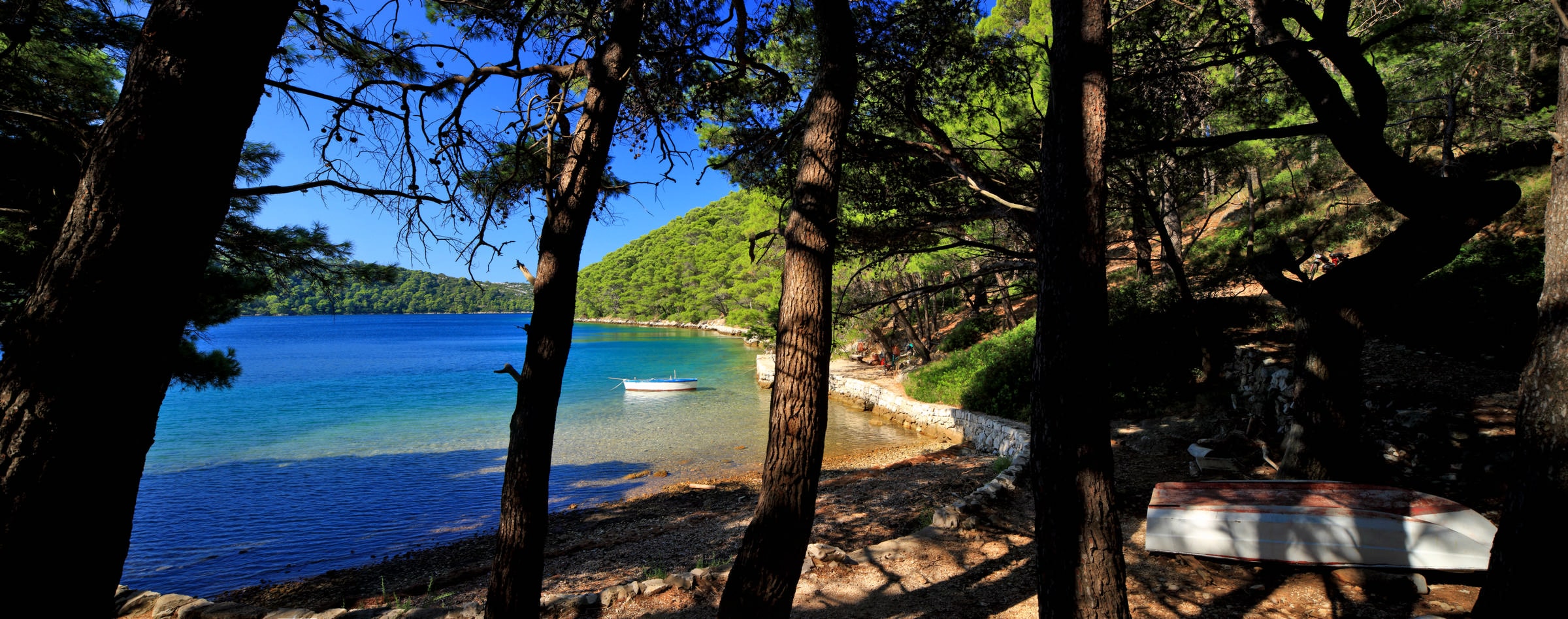 Mljet island / Photo © Mario Romulic
Mljet island / Photo © Mario Romulic
The programme takes place in April and is seven days long, including six days of work and one day off. Volunteers are expected to work six hours a day with a one-hour break, but considering that the physical work involved in this particular programme can be strenuous, the number or working hours can be reduced if needed.
All necessary tools will be provided by the Park. Accommodation is provided free of charge on Mljet island in the Collier building owned by the Park, which has seven rooms equipped with bunk beds, toilets, showers, a kitchen and a living room. Meals are also provided free of charge, with the Park delivering groceries to volunteers or providing free meals at the local hotel.
If stonemasonry isn’t your cup of tea and you’d prefer a less hands-on kind of creative work, may we suggest another volunteer programme on Mljet island:
2. Photo Amateur in Mljet National Park
A dream come true for anyone who loves island hopping and snapping pics of stunning landscapes (don’t we all?), this programme involves photographing the scenery and events in Mljet National Park in the period between April and June.
Depending on the time of year, volunteers will be required to photograph various locations, events and activities on Mljet island using their own gear. You’ll be capturing the island’s flora and fauna, cultural monuments and landmarks, historic sites, enchanting landscapes and fun summer events.
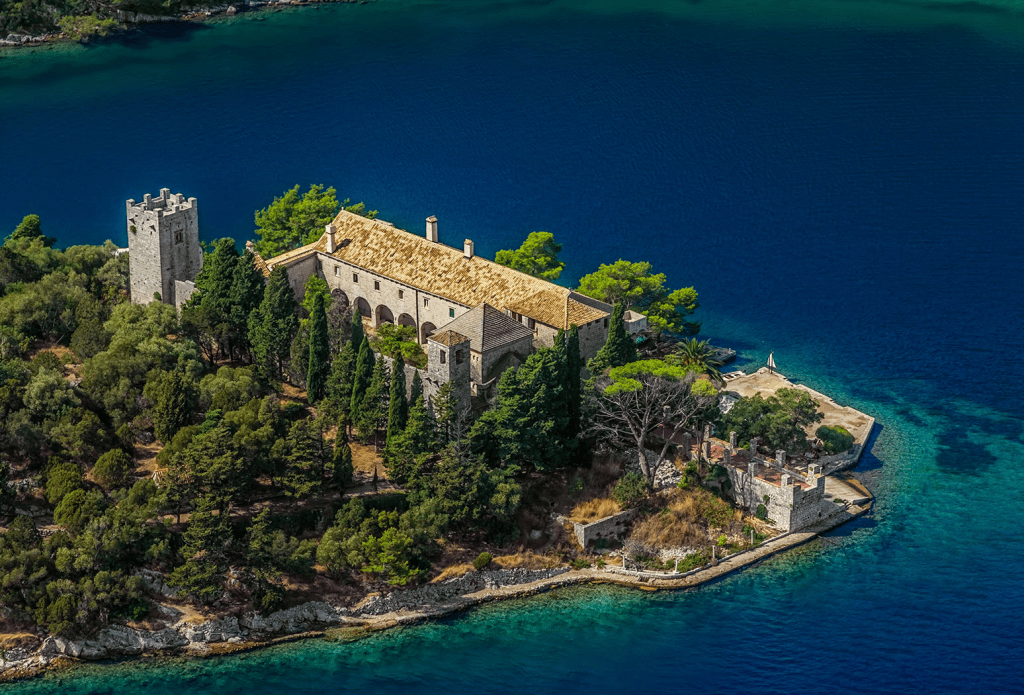 Mljet National Park / Photo: volonteri.parkovihrvatske.hr
Mljet National Park / Photo: volonteri.parkovihrvatske.hr
Those who choose to participate in this particular programme will sign a statement of the assignment of the photos to Mljet National Park. You’ll have to submit the photos shortly after the programme is over, and can look forward to seeing them featured in the Park’s publications in Croatia and abroad.
A minimum of one DSLR camera with a lens is required to partake in this programme.
You’ll have plenty of time to explore the island on your own time, and there’s no shortage of things to do: there are over 40 kilometres of hiking and cycling trails, you can rent a kayak or canoe to explore the saltwater lakes on Mljet, or take diving lessons with a certified instructor.
For all Mljet-based programmes, volunteers are to bear the cost of travel to Mljet island, and the Park will provide transport from the ferry port on Mljet to the place of accommodation.
3. Gull Catcher in Kornati National Park
Are you a fan of the great outdoors and love being in close contact with wildlife? Consider becoming a seagull catcher in Kornati National Park. Don't worry, you'll be releasing them too!
You’ll be joining the Park’s experts as they band and monitor Caspian gulls in the stunning Kornati archipelago, specifically on a few islands where seagulls are known to nest.
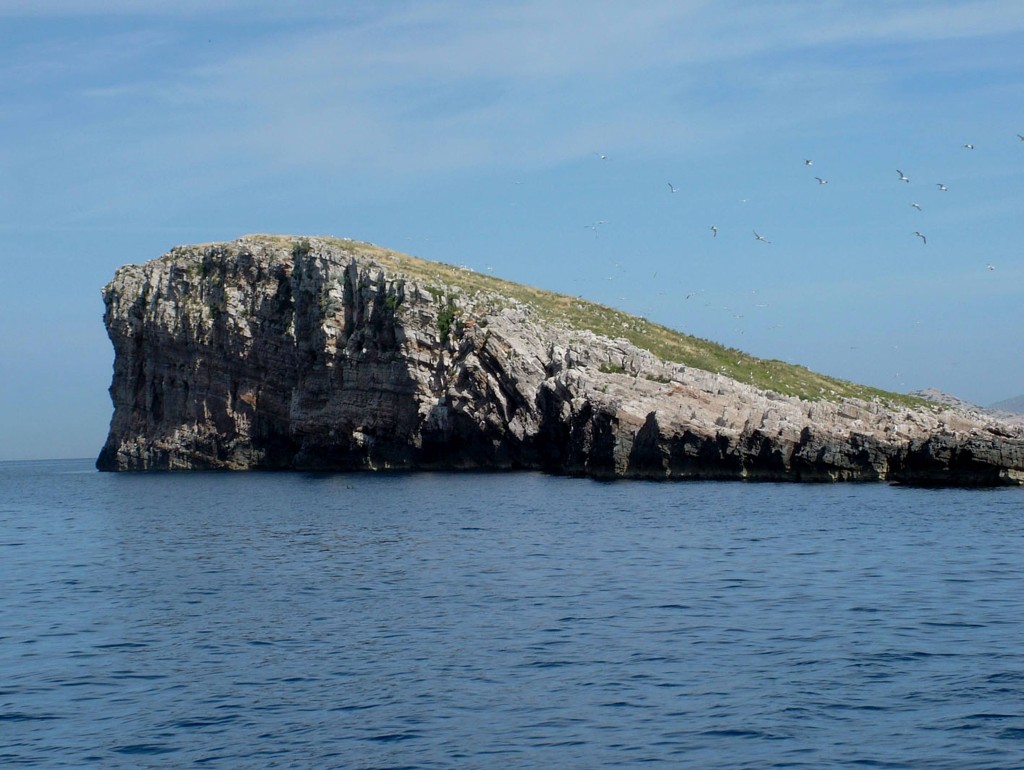 Kornati National Park / Photo: volonteri.parkovihrvatske.hr
Kornati National Park / Photo: volonteri.parkovihrvatske.hr
Do you dare to catch a young gull with your bare hands? If you do, you get to name the bird and take notes as it gets banded by a qualified employee of the Park. Banding and monitoring allows experts to track the behaviour and habitats of seagulls in order to collect data used to ensure protection of the species.
Volunteers will receive training prior to starting work and will be supervised by the Park staff. The programme takes place in May and June lasts about ten days, with volunteers expected to work seven hours a day.
Accommodation is provided and free, and in this case, it’s pretty amazing: you’ll be staying on a sailboat owned by the National Park Kornati, fully furnished and featuring 3 cabins, 6 beds, a living room, kitchen and toilet.
 Kornati National Park / Photo © Mario Romulic
Kornati National Park / Photo © Mario Romulic
Groceries are provided free of charge, and volunteers can either prepare meals on their own or seek the help of the volunteer manager.
Volunteers have to arrange transportation to Murter island, while further transport from Murter and within the Park area is organised by the Park and free of charge.
4. Traditional Gardener in Lonjsko Polje Nature Park
Lonjsko Polje (Lonja Field) is the largest protected wetland in Croatia, located approximately 70 km south-east of Zagreb.
If you have a green thumb and don’t mind getting your hands dirty, you’d be a great fit for a traditional gardener in Lonjsko Polje Nature Park. You’d help clean up the untended plots in the Park and plant new seedlings around traditional wooden houses in the villages of Krapje and Čigoč - think of it as traditional landscape design!
 Lonjsko Polje Nature Park / Photo © Mario Romulic
Lonjsko Polje Nature Park / Photo © Mario Romulic
The programme takes place in April and lasts five days, six hours of work each.
Accommodation is provided free of charge in a dormitory in Krapje. The facility is equipped with a small kitchen and a bathroom, and has central heating. As volunteers will be sleeping on spare beds, they are required to bring their own sleeping bags. Groceries are provided free of charge, and bikes and vehicles are available to use for transportation within the Park.
5. Guardian of Plant Biodiversity in Brijuni National Park
There’s not much need for gardening on Brijuni islands - domestic wildlife and imported species such as mountain zebras and mouflons take care of landscaping by nibbling away at the grass at all times.
There’s a single item on the menu that the animals don’t like: a spiky flower called Spanish oyster thistle. Since the wildlife practically mows the lawn, it removes all natural obstacles that would prevent the spread of the Spanish oyster thistle, allowing it to take over whole areas that would otherwise be home to other plants.
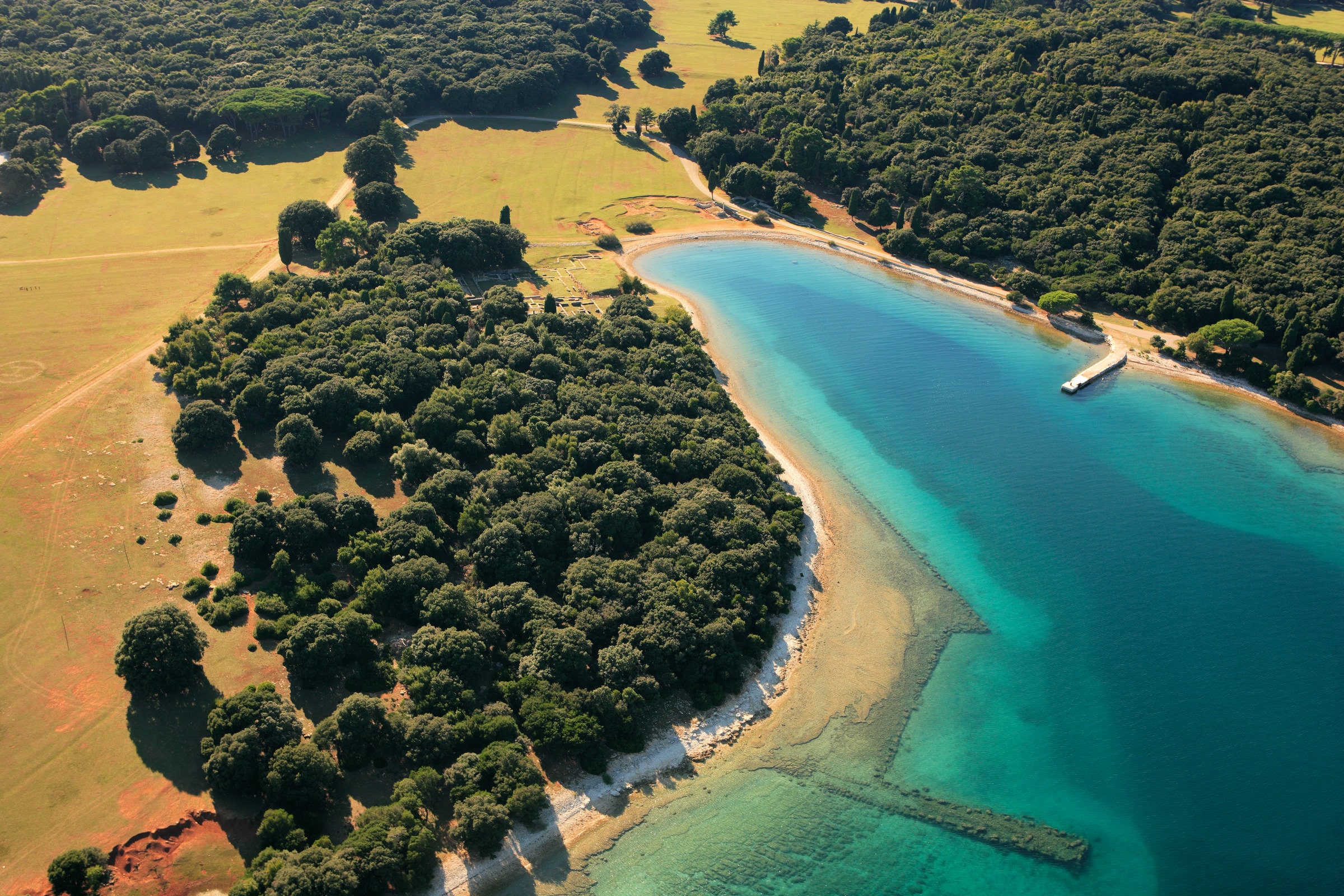 Brijuni islands / Photo © Mario Romulic
Brijuni islands / Photo © Mario Romulic
As a volunteer, you’ll help maintain the biodiversity on the meadows of Veliki Brijun island by keeping the pesky thistle in check. You’ll be removing the aggressive plant using provided gardening tools.
Volunteers are needed in the month of May and are required to put in 6 hours of work daily. Beyond that, the islands are yours to enjoy: explore the Safari and Ethno Parks, rent golf equipment and play on the golf course opened in 1922, or go for a swim at one of Brijuni’s pristine beaches.
The Brijuni are also a nice jumping off point for trips in Istria. Discover the ancient Roman monuments in Pula which is located only 7km away from Fažana, or visit the picture-perfect city of Rovinj.
 Wildlife on Brijuni islands / Photo © Mario Romulic
Wildlife on Brijuni islands / Photo © Mario Romulic
Accommodation is provided in one of the apartment buildings on Veliki Brijun island that are owned by the Park. Apartments are equipped with toilets, bathrooms, and a kitchen; rooms are shared with one or two other volunteers.
Groceries are provided free of charge and delivered to the apartment building, and one meal a day is also provided free of charge in the workers’ restaurant.
Volunteers have to arrange transport to Fažana town, and boat transportation to and from Veliki Brijun island is organised by the Park free of charge for the duration of the volunteer programme.
***
Applicants who don’t speak Croatian must be able to speak English in order to communicate with the park authorities and volunteer coordinators.
You can find more information about these and other volunteer programmes on the website Volunteer in Parks of Croatia.
Looking to apply? Fill out this form (in English), pick a programme you like and specify when you're free to participate, and the relevant programme coordinators will get back to you.
Please note that some of the programmes might not be accepting applications for the time being, or might be otherwise affected by epidemiological measures.
Check out our comprehensive Guide to the Nature and National Parks of Croatia.
Lonjsko Polje Nature Park Observatories Add to Growing Tourist Offer
August 22, 2021 - Lonjsko Polje Nature Park observatories are yet another addition tempting visitors this summer.
To increase the attractiveness and educational capacity of Lonjsko Polje Nature Park by building a visitor center, "Crna Roda Osekovo," Lonjsko polje Nature Park has enriched its tourist offer with three new observatories that further attract visitors to the park.
The "Roda" observatory is located not far from the Visitor Center Čigoč, the "Ptica kosac" observatory is near the visitor center Repušnica, while the "Traditional fishing" observatory is located right by the river Lonja not far from the Visitor Center Osekovo, which is expected to open in September.
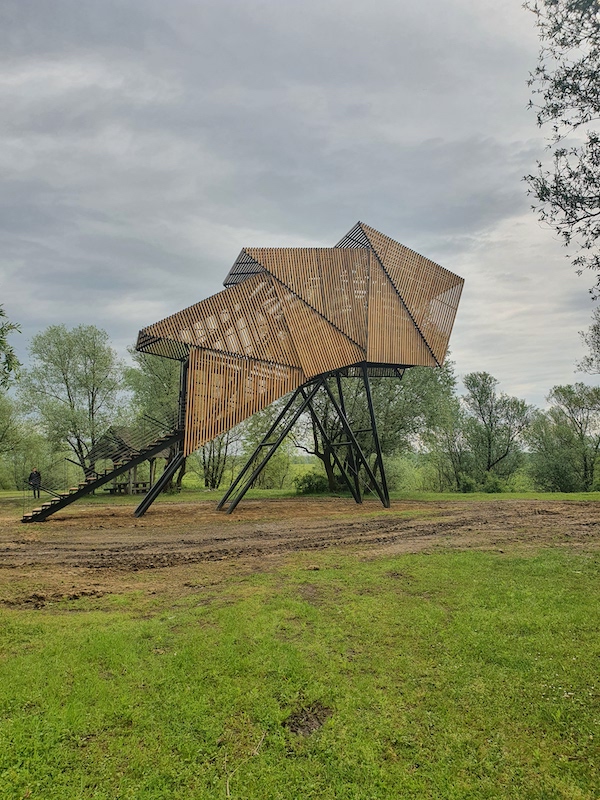
"By building observatories, we have additionally enriched the content we offer to visitors. Visitors are delighted with their appearance and the scenes they can see from the observatories because the observatories are located in attractive locations near the Lonja River or the plains where indigenous animals live. Visitors can visit these localities, and they will find out how to get to them at our info centers," said the director of the Public Institution Lonjsko Polje Nature Park, Marija Kušmiš.
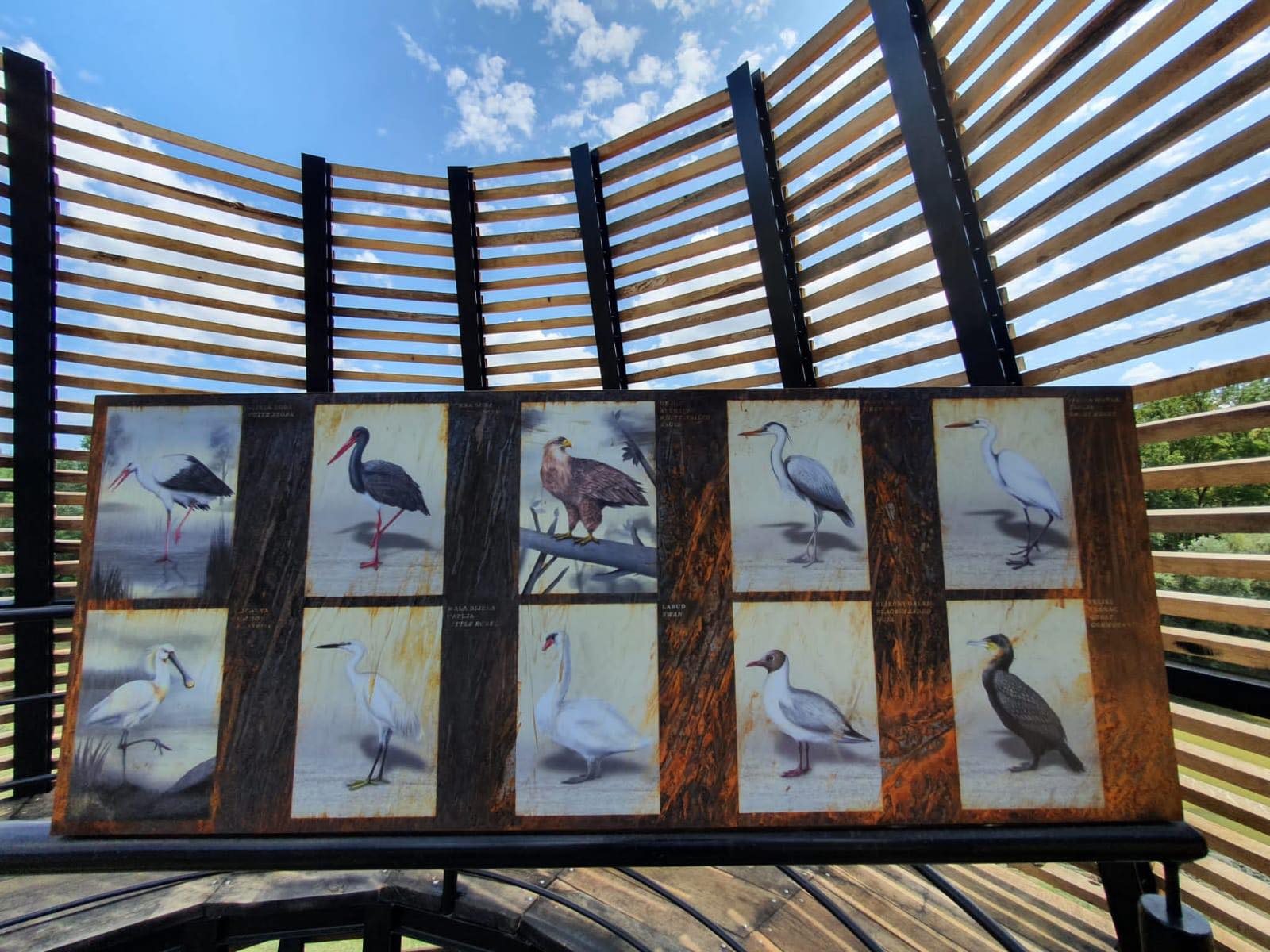
The construction is co-financed by the European Union from the European Regional Development Fund through the Operational Program Competitiveness and Cohesion and the Ministry of Economy and Sustainable Development, and the Fund for Environmental Protection and Energy Efficiency. The Roth i Čerina d.o.o. design team is responsible for their look.
Recall, just a few weeks ago, the third-largest protected park in Croatia also introduced bitcoin and other cryptocurrencies as a means of payment.
Thus, visitors can purchase tickets with cryptocurrencies via Eletrocoin PayCek for a solar-powered boat ride on the Strug river, known as the "Slavonian Amazon," a tour of the "Posavina safari" - a traditional pasture, a tour of the ornithological reserve Krapje đol and observe the fields from the new observatories "Bird reaper," "White Stork" or "Vrška." Visitors can also use the currency for all services and souvenirs.
“We are glad to be the first nature park to introduce this service. We certainly encourage investors in cryptocurrencies to think about the importance of the protected area, its sustainability, but also to enjoy the natural beauty," said Marija Kušmiš, director of the Lonjsko Polje Nature Park.
Electrocoin d.o.o. points out that the interest of business entities in introducing payments for their products and services in cryptocurrencies is constantly growing. Furthermore, they are extremely pleased that this trend is not exclusively related to companies in the technology and finance segment. An excellent example of this is the excellent cooperation with Lonjsko Polje Nature Park, which recognized the potential of implementing the PayCek cryptocurrency payment system in its business and thus showed that it not only keeps pace with future technological trends but also recognizes the need for a new generation of consumers.
Lonjsko Polje is the first park in Croatia, and beyond that has allowed its visitors to visit the Park and enjoy other content from the offer by paying in cryptocurrencies.
For all you need to know about Lonjsko Polje, be sure to follow our dedicated page on Total Croatia.
For more on travel in Croatia, follow TCN's dedicated page.
First in Croatia: Lonjsko Polje Nature Park Accepts Cryptocurrencies
August 2, 2021 - Lonjsko Polje Nature Park accepts cryptocurrencies and is the first nature park in Croatia to welcome digital money!
Virtual and digital currencies are becoming increasingly popular. Just a few days ago, El Salvador became the first country in the world to introduce bitcoin as the official currency, i.e., a parallel legal tender with the US dollar.
Now, the third-largest protected park in Croatia, Lonjsko Polje Nature Park, apart from the kuna, has introduced bitcoin and other cryptocurrencies as a means of payment, reports HRTurizam.
Thus, visitors can purchase tickets with cryptocurrencies via Eletrocoin PayCek for a solar-powered boat ride on the Strug river, known as the "Slavonian Amazon," a tour of the "Posavina safari" - a traditional pasture, a tour of the ornithological reserve Krapje đol and observe the fields from the new observatories "Bird reaper," "White Stork" or "Vrška,". Visitors can also use the currency for all services and souvenirs.

“We are glad to be the first nature park to introduce this service. We certainly encourage investors in cryptocurrencies to think about the importance of the protected area, its sustainability, but also to enjoy the natural beauty," said Marija Kušmiš, director of the Lonjsko Polje Nature Park.
Electrocoin d.o.o. points out that the interest of business entities in introducing payments for their products and services in cryptocurrencies is constantly growing. They are extremely pleased that this trend is not exclusively related to companies in the technology and finance segment. An excellent example of this is the excellent cooperation with Lonjsko Polje Nature Park, which recognized the potential of implementing the PayCek cryptocurrency payment system in its business and thus showed that it not only keeps pace with future technological trends but also recognizes the need for a new generation of consumers.
Lonjsko Polje is the first park in Croatia and beyond, which since yesterday has allowed its visitors to visit the Park and enjoy other content from the offer by paying in cryptocurrencies.
For more on travel in Croatia, follow TCN's dedicated page.
Lonjsko Polje Park Records Three-Digit Rise in Visitor Stats
ZAGREB, 25 July, 2021 - The Lonjsko Polje Nature Park has seen a three-digit rise in visitors' statistics so far this year compared to 2020, and the planned opening of a centre for the black stork (ciconia nigra) in September will make the park even more attractive for guests, the park's representatives have told Hina.
In the first half of 2021, the number of visitors in this nature park, 90 kilometres southeast of Zagreb, skyrocketed by 150% compared to H1 2020, however the figures are still below the pre-pandemic period.
Broken down by citizenship, apart from local guests from all parts of Croatia, there were also more and more French, German, Polish and British travellers visiting this part of Croatia.
Of the 250 bird species living in the park, 170 also nest there. The village of Čigoč is known as the stork village.
A new centre dedicated to the black stork in the village of Osekovo will be opened within the park in September, and this project, worth 20 million kuna, has been co-funded by the European Union in the amount of HRK 12.8 million.
Some of the attractions in the 511-square-kilometre-large park are the village of Krapje, bird-watching in the ornithological reserve Krapje Đol, and traditional cattle grazing in Repušnicko Polje field.
The park, which is the largest protected wetland in Croatia is in the basin of the Sava and Lonja rivers.
For more on Travel, follow TCN's dedicated page.
For more about Croatia, CLICK HERE.
"Invasive Species in Croatia" Mobile Application Launched
ZAGREB, 2 May 2021 - One of the biggest ecological challenges today are invasive alien species which will be possible to track by a mobile application called "Invasive species in Croatia", which was launched earlier this week in Krapje, a community in Sisak-Moslavina County.
The application, developed by the Economy and Sustainable Development Ministry, was presented to rangers and other staff working in protected areas located by the River Sava.
"The information system for invasive alien species provides existing information on alien species in Croatia in a single, publicly available place. It will be updated, which is why the application has been developed, to enable citizens to report their observations," said Ana Ješovnik of the Office for Alien Species of the Institute for Environment and Nature Protection at the Economy and Sustainable Development Ministry.
"This system will help monitor not only the number and appearance of invasive alien species but also trends in their expansion, and it will also improve management planning to prevent their harmful effect on biodiversity," she said.
Sandra Slivar of the Office for Alien Species underlined the importance of rangers who are among the first to spot the appearance and spreading of an invasive alien species. Their input, she said, helps plan the protection of protected species and habitats.
The European Union has compiled a list of invasive species, and on that list of 66 animal and plant species, 24 have been reported in Croatia.
Burdock, desert false indigo among invasive species in Lonjsko Polje
Among the dozen invasive species that have been identified in the Lonjsko Polje Nature Park, the most important ones are burdock, goldenrods, wild cucumber, and desert false indigo, which in the past 30 years or so has spread over most of the marshes in the park, or around 5,000 hectares of land, and the park management has so far revitalized around 600 hectares of land through donations.
"The Lonjsko Polje Nature Park has been battling invasive alien species for years. Participation in the Sava TIES project in the past three years has helped do a lot in the field of research, improvement of the legislative framework as well as in raising the level of interdepartmental and cross-border cooperation," the park's director, Marija Kušmiš, said.
Invasive alien species have a negative effect on biodiversity and eco-systems and some of them jeopardize the economy as well as human health, she said.
The spreading of invasive alien species reduces the area of marsh habitats of many strictly protected animal and plant species, it was said.
For more news about everything made in Croatia, be sure to visit our dedicated section.
Name Lonjsko Polje Nature Park Storks and Watch Them via Live Stream!
April 29, 2021 - The public is invited to name the Lonjsko Polje Nature Park storks and can even watch them via live stream! Name proposals are being accepted until May 10.
While Malena and Klepetan in Brodski Varoš, near Slavonski Brod, the most glamorous stork couple in Croatia still shine with that celebrity-like glow, new stork generations are always coming. Perhaps ''The New Wings on the Block'' who will one day conquer the scene, can be found in the ever famous and attractive Lonjsko Polje Nature Park.
Čigoč village is already known as the first stork village in Europe for the various nests on the wooden roofs of its houses. As Turističke Priče reports, the Lonjsko Polje Nature Park authorities are inviting the public to name the storks in Čigoč village as they're still nameless. The storks' nests can be monitored on a livestream on the official Lonjsko Polje website, and the audience can send in their name suggestions in the comment sections until May 10. Lonjsko Polje's employees will decide which names best fit the individual storks.
Lonjsko Polje was declared a nature park back in 1990 and is located 75 kilometres from Zagreb. It's an easily accessible place to visit from Croatia's capital and other places in central Croatia. In addition to storks which are the most famous birds in the area, 350 different bird species have made Lonjsko Polje their home. Indigenous species of cows, Posavina horses, and Turopolje pigs are also found there. The wooden houses are created without using one single nail, making them a superior architectural site and not just great nesting places for birds.
The newly opened Osekovo Visitor Centre is specialised for its educational content focused the black stork, an endangered species in Croatia, and its mascot, Barica, makes it interesting and child-friendly. The entire park is a great place to go on a family trip.
''A ticket for a weekend program is 50 kuna per person, 5 kuna per child ages three to six, and 15 kuna for children 7-10 years old. The price includes walking around and sightseeing in Krapje village with its construction heritage, the Krapje Djol ornithological reserve and riding the solar-powered boat and tourist train. The Repusnica Visitor Centre offers walks by the Vrbacinec excursion site, while the Čigoč Visitor Centre will tell you a story about the white stork every Sunday at 13:00, and then you can sightsee Čigoč and Lonjsko Polje“, writes the Turističke Priče site.
Learn more about Lonjsko Polje on our TC page.
For more about travel in Croatia, follow TCN's dedicated page.
Croatian Wetland Areas Mark 50th World Wetlands Day
February 2, 2021 – Today is the jubilee 50th World Wetlands Day. Croatia marks this year's theme "Wetlands and Water" in line with epidemiological measures, as many public institutions of Croatian wetland areas organize numerous online and offline activities.
On the occasion of World Wetlands Day, the Ministry of Economy and Sustainable Development has pointed to a growing freshwater shortage crisis that poses a significant threat to humanity and the planet. This year's theme – Wetlands and water – pays special attention to wetlands as a freshwater source.
50 percent of wetlands lost in the last 50 years
Croatia has several wetlands: Nature Parks Kopački Rit, Lonjsko Polje, and Vrana Lake, the Special Reserve Crna Mlaka in Jastrebarsko, and the Lower Neretva River. Croatian wetland areas seek to encourage actions to restore wetlands and stop their loss by marking World Wetlands Day.
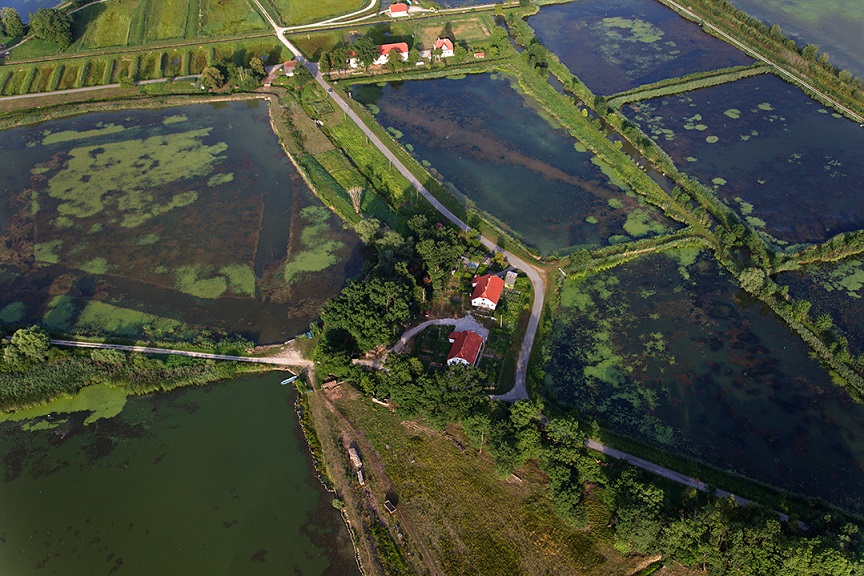
Crna Mlaka in Jastrebarsko / Public Institution Green Ring of the Zagreb County
On this day in 1971, the Convention on Wetlands of International Importance, Especially as Waterfowl Habitat, was signed in the Iranian city of Ramsar. The Convention, known as the Ramsar Convention, obliges each signatory country to the general conservation of wetlands on its territory and provides a framework for international cooperation in protecting and sustainable use of wetlands.
Croatia has been a signatory to the Ramsar Convention since 1991, and the above mentioned Croatian wetland areas are on the Ramsar Convention's list.
As a contribution to implementing the Ramsar Convention in Croatia, three relatively small areas within the Neretva delta were proclaimed as special reserves last year. The places named "Blue Eye and Lake Desna," "Neretva's Estuary," and "Kuti" have preserved, unique, and representative wetland habitats and characteristic species of particular importance for Croatia.

Neretva River / Copyright Romulić and Stojčić
Although wetland habitats represent one of the greatest values of biological and landscape diversity, since more than 40 percent of plant and animal species are associated with them, they are also the most endangered ecosystems in the world. In the last 50 years, 50 percent of all wetlands in the world have been lost.
Wetland areas as the best flood defense
Apart from being wet habitats for numerous plant and animal species, they are also crucial in adapting to climate change. Thus, wetland habitats are extremely important in flood defense, especially in Croatia.
Lowland rivers with moist habitats along their trough, into which they flow during high water levels, represent the best way to defend against floods. This is precisely how the flood defense system in Posavina was built. Thus, high waters of the Sava River flow into the Lonjsko Polje Nature Park floodplains, while Kopački Rit Nature Park "receives" high waters of the Drava and Danube, thereby changing their landscapes.
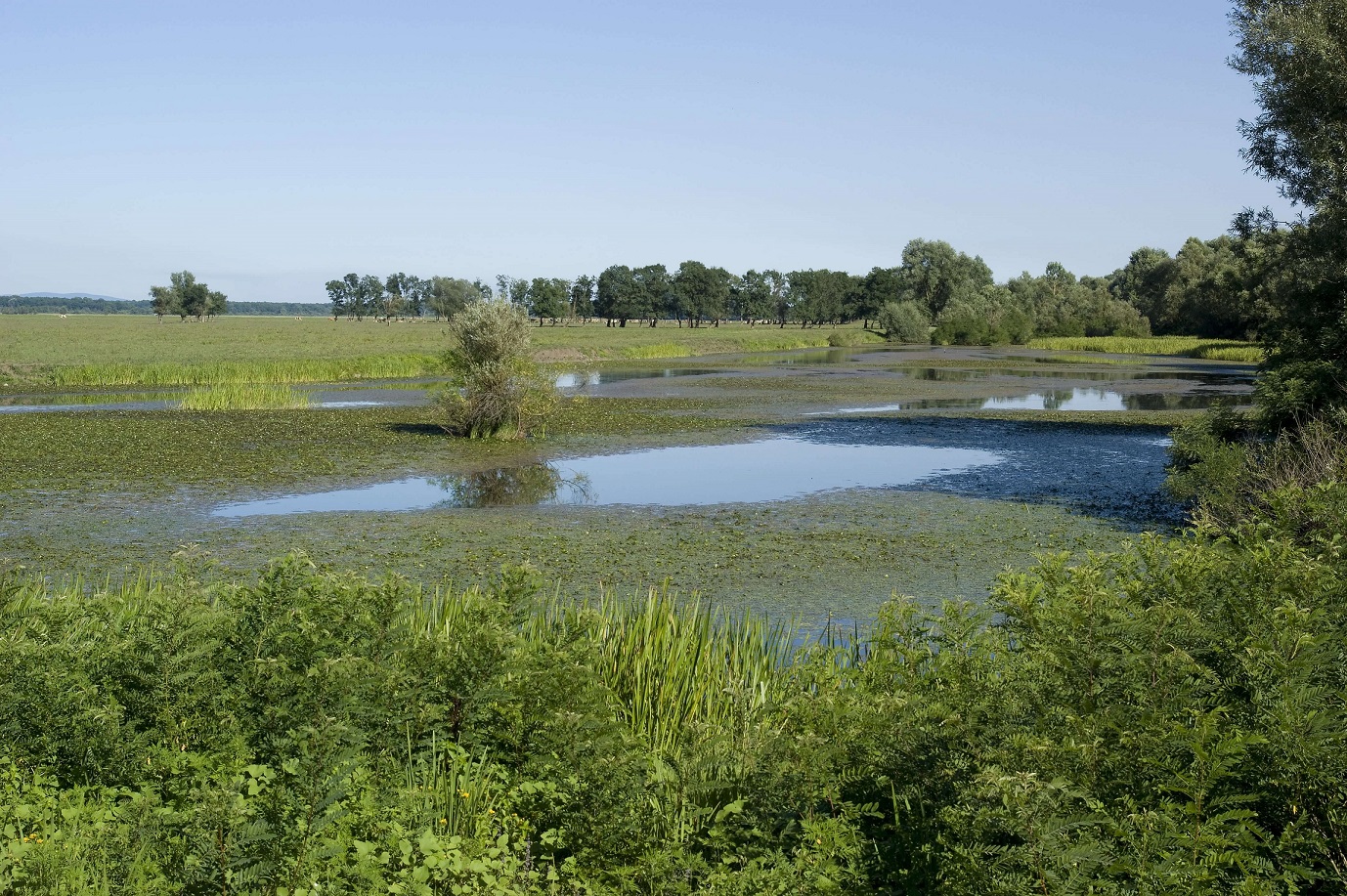
Lonjsko Polje Nature Park
The value of wetland habitats is also related to the restoration of groundwater supplies, the consolidation of shores, the retention of nutrients and sediments, and water purification. On World Wetlands Day, public institutions that manage protected areas in Croatia organize numerous activities.
Due to epidemiological measures, Lonjsko Polje Nature Park will not organize the traditional gathering "Future on the edge of the swamp" this year. However, the importance of water and wetlands will be discussed at a small event at the Public Institution headquarters in Krapje.
As part of this event, Matica Hrvatska's branch from Kutina will review the meetings "Future on the Edge of the Swamp" in the last 20 years. Employees of the Public Institution will participate in a workshop on the construction of roof platforms for white stork nests.

Village of Krapje / Lonjsko Polje Nature Park Boris Krstinić
In Northern Dalmatia, Vrana Lake Nature Park continues cooperation with the School of Applied Arts and Design in Zadar. Students will have virtual and field lectures on the topic of wetlands, their importance, and rich biodiversity, emphasizing birds. Students will create illustrations of different bird species presented in a virtual exhibition on the Park's website.
The traditional 9th "Bird Masquerade" will be organized for primary school students, and students from 1st to 4th grade of local primary schools will make masks of wetland birds. On February 6, free bird watching will be organized for all visitors.
The promotional video "Vrana Lake Nature Park: a place where birds always return" by the author Goran Šafarek will be shown for the first time:
Kopački Rit Nature Park traditionally celebrates World Wetlands Day in cooperation with Elementary School in Bilje. Second-grade students prepared artworks, literary ensembles, and a musical performance on the topic of Kopački Rit and its natural features. A lovely presentation of their work is also available online.
The Public Institution for the Management of Protected Nature Areas of the Dubrovnik-Neretva County conducts education on the importance of wetlands through an LED screen in Metković, where images with short educational texts about wetlands will be shown.
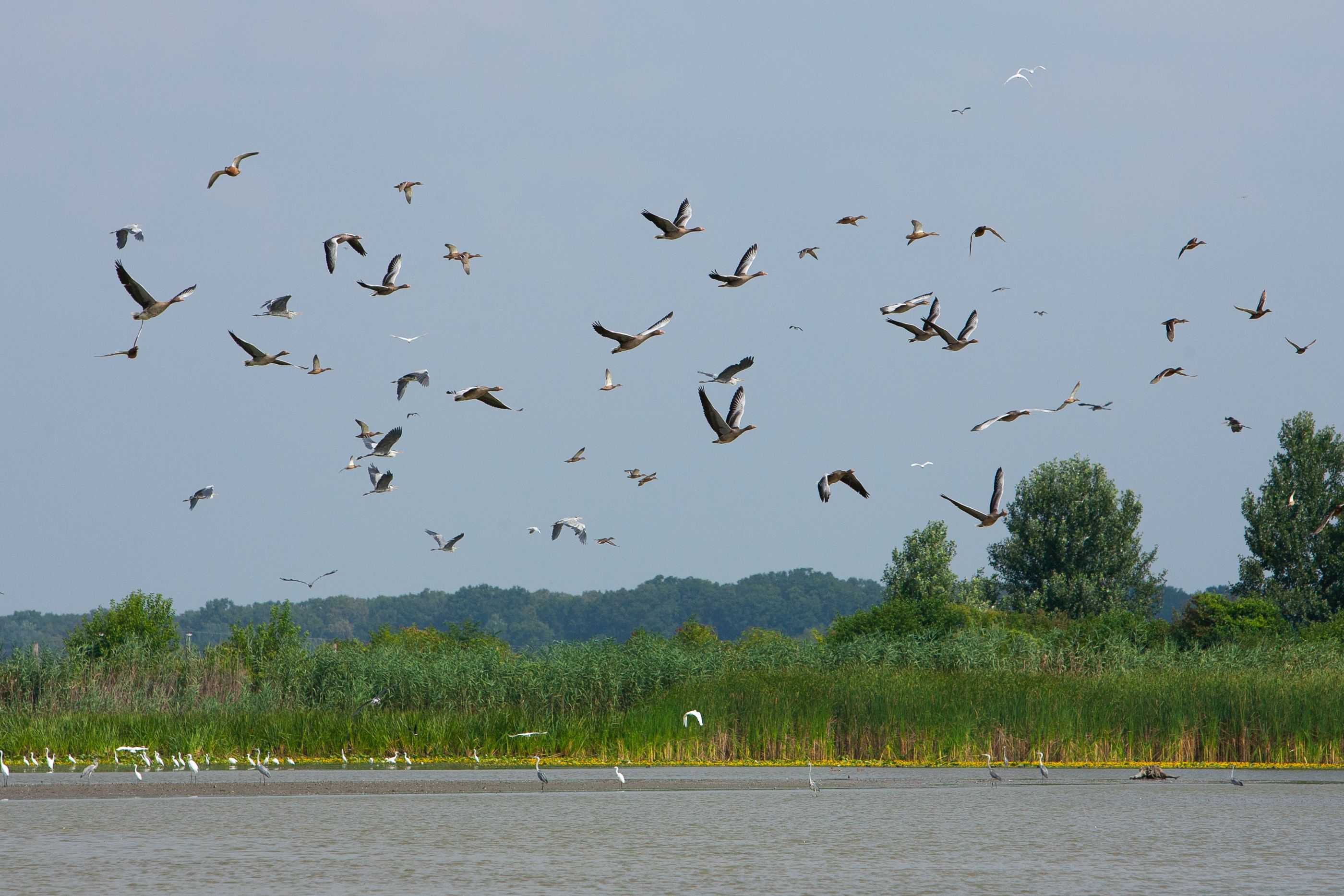
Kopački Rit Nature Park / Copyright Romulić and Stojčić
Lonjsko Polje Nature Park Sees 50% more Visitors
ZAGREB, Oct 21, 2020 - Lonjsko Polje Nature Park this year had about 50% more visitors than last year, which is a result of increased communication activities, but also of people turning to nature and spending time outdoors, the director of Lonjsko Polje Nature Park, Marija Kusmis, said.
"We have adapted quickly and systematically to the new circumstances and people have recognized that, and although we opened the Park two months later than usual this year, in May, we had twice as many individual visitors than last year, 5,300 of them," Kusmis said in a press release on Tuesday.
A new way of managing visits to the Park has been introduced, she says, and after kindergartens, schools, and groups of pensioners canceled their visits, communication was shifted to families with children, nature lovers, and all those who like an active lifestyle and nature.
"All employees and visitors have been adhering to the measures and recommendations by epidemiologists, and thanks to the nice weather in these autumn days, we believe that the number of visitors will grow further, especially in the 'Week of Vacation', when we reduced ticket prices by 50%," Kusmis said.
She said that they had increased their tourist offer and that they now managed the boat Juran and Sofija, which sailed along the Kupa River in Sisak, and boats and canoes in the eco-ethno village Strug were available, as well as professional guides.
Some of the attractions she mentioned also include visiting the village Krapje, where people and Lonjsko Polje coexist, bird-watching in the ornithological reserve Krapje Djol, and traditional cattle grazing in Repusnicko Polje field.
For the latest travel info, bookmark our main travel info article, which is updated daily.
Read the Croatian Travel Update in your language - now available in 24 languages
Eco Ethno Village Strug: Weekend Escape to an Idyllic Countryside
October 9, 2020 – Even though rural areas in Croatia are not as popular as urban ones, they also hide immense traditional beauty. Check out the Eco Ethno village Strug, a perfect place to enjoy nature and traditional Posavina dishes in the company of many domestic animals.
Rural tourism in Croatia has a lot to offer. One of such beautiful rural areas is the Eco-Ethno village Strug, a rural tourist estate known for its magical scenes of idyllic countryside.
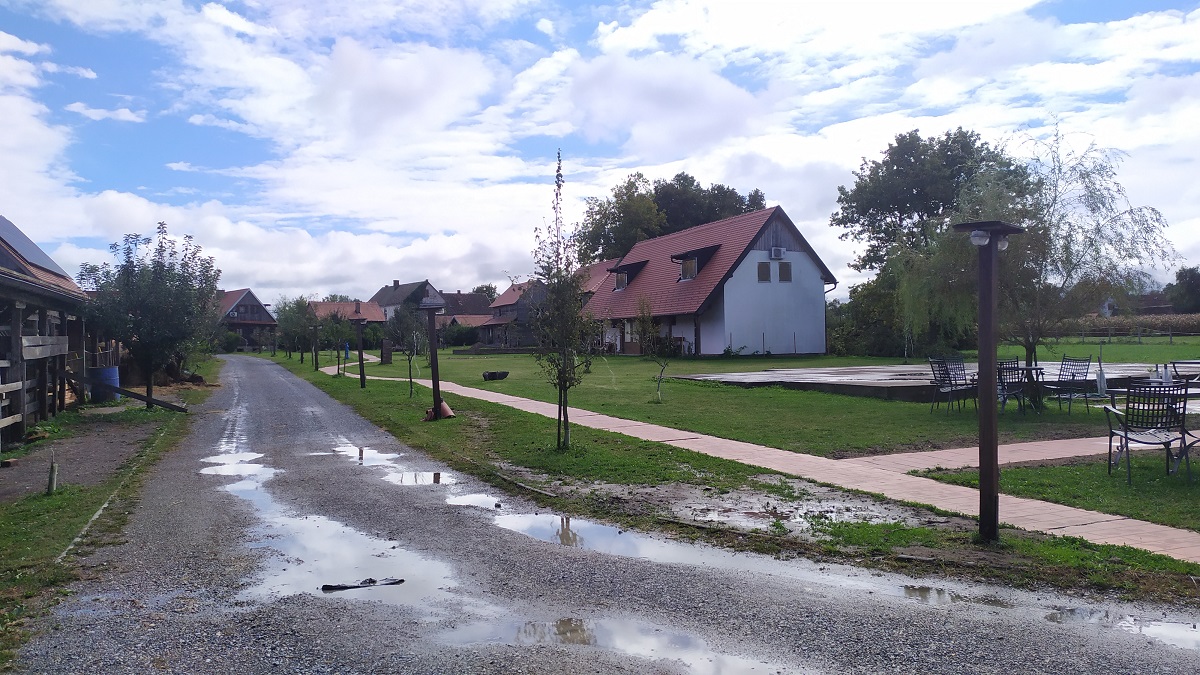
Rainy and cloudy day at the Eco-Ethno village Strug / Donatella Pauković
And yes, by saying the countryside, it is a village with an unusual surrounding of untouched nature, dirt, mud (when it rains), and domestic animals. But it all makes the experience of visiting unique and real!
Calmness and relaxation
The Eco-ethno village Strug is located in a small village of Plesmo in the heart of Posavina and is part of the Nature Park Lonjsko Polje. The name Strug was given after the eponymous Posavina canal that flows in the area.
The whole estate contains several decorated traditional oak houses for staying overnight, and a restaurant with traditional dishes overlooking the small excavated pond, and a large pasture where Posavina horses graze and run freely. The whole atmosphere at the estate is so calm and relaxing you almost feel like you're ruining it. You can feel it in the video below:
To complete the atmosphere, the rooms and apartments are decorated in an authentic ethno style but are equipped with a television, safe, central heating, air conditioner, and a refrigerator. In this remote village 30 minutes away from the closest small town of Novska, it is difficult to catch a mobile signal, but the cottages and the restaurant have free wireless internet.
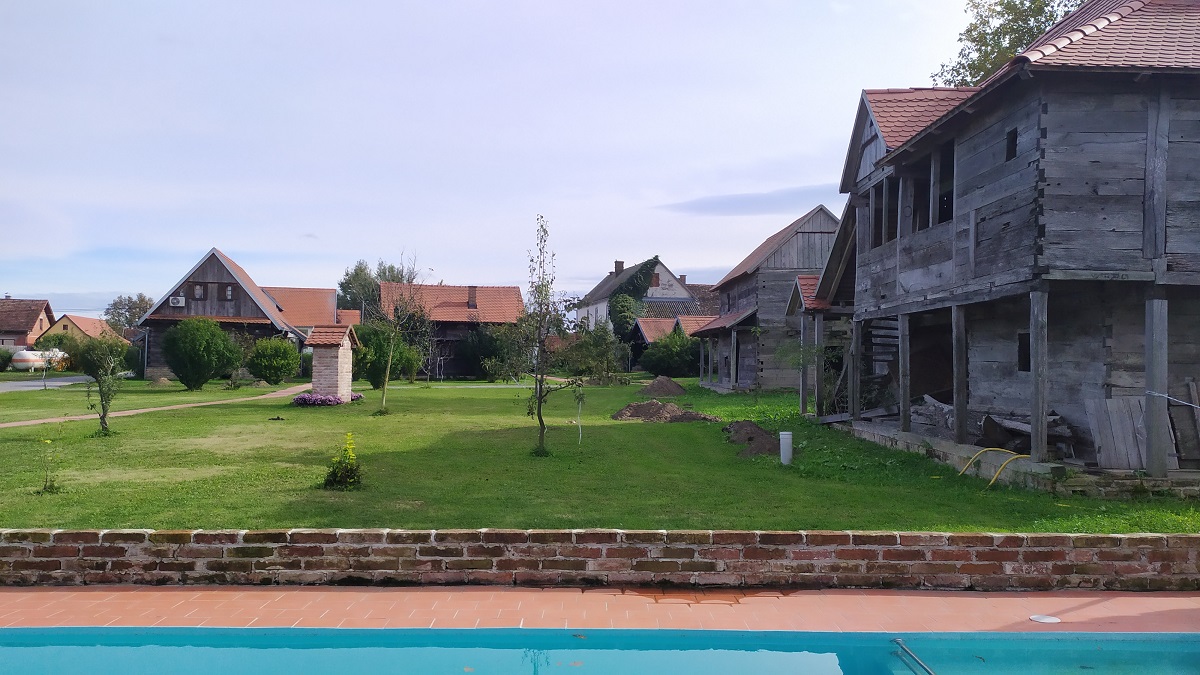
Traditional oak houses (in the distance) and a wooden shed (on the right) / Donatella Pauković
The restaurant can be visited whether you want to have lunch, dinner, or just enjoy an afternoon coffee watching the domestic farm animals, which makes a perfect weekend getaway.
The whole atmosphere at the Eco-Ethno village Strug is calm and relaxing / Donatella Pauković
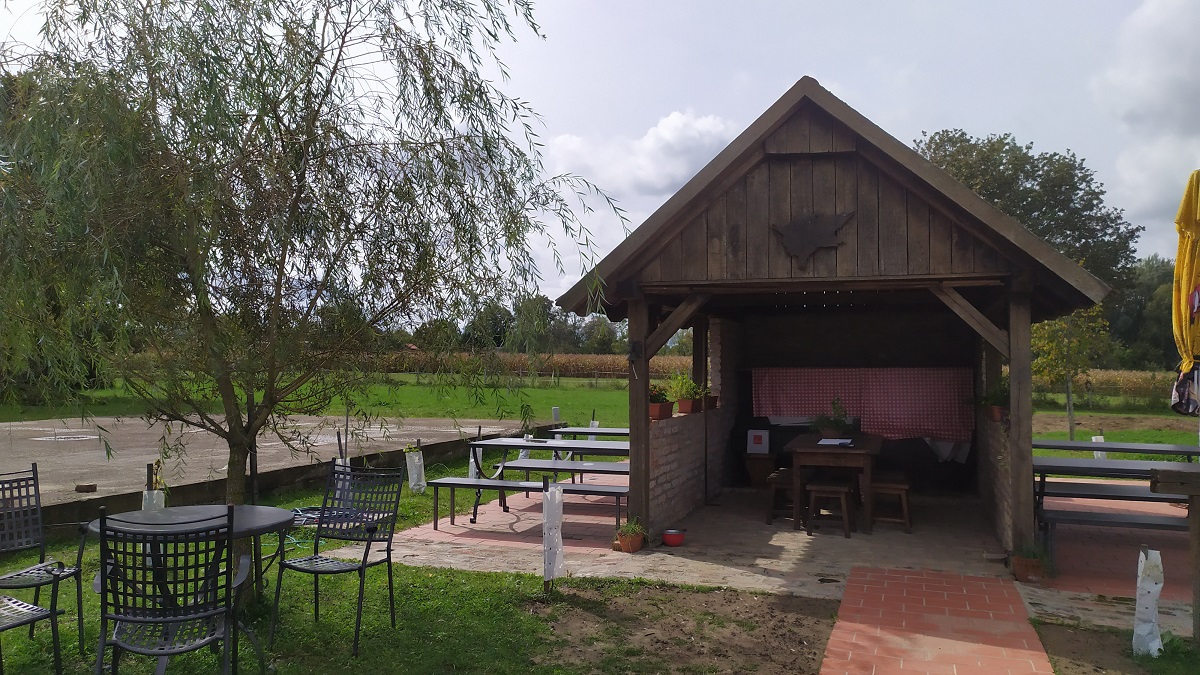
A small eaves and a terrace in front of the restaurant that can be used when it's hot and sunny / Donatella Pauković
Food heaven
The restaurant offers many Posavina traditional specialties, of which the most prominent is venison. Deer in cranberry sauce and boar in the plum sauce are dishes that must be tasted here, and river fish specialties such as perch, catfish, and pike are also offered.
The interior of the restaurant / Donatella Pauković
For an appetizer, they offer a traditional type of pasta called “trganci“ with sour cream and baked bacon, and an interesting side dish, which is not common in restaurants – polenta with sour cream. For dessert, Posavina specialties are also served, such as dumplings topped with sour cream and poppy seeds or plums.
The food they serve originally comes from the local area, and, as they say, "it is prepared in a traditional domestic manner according to long-forgotten recipes of the Posavina region".
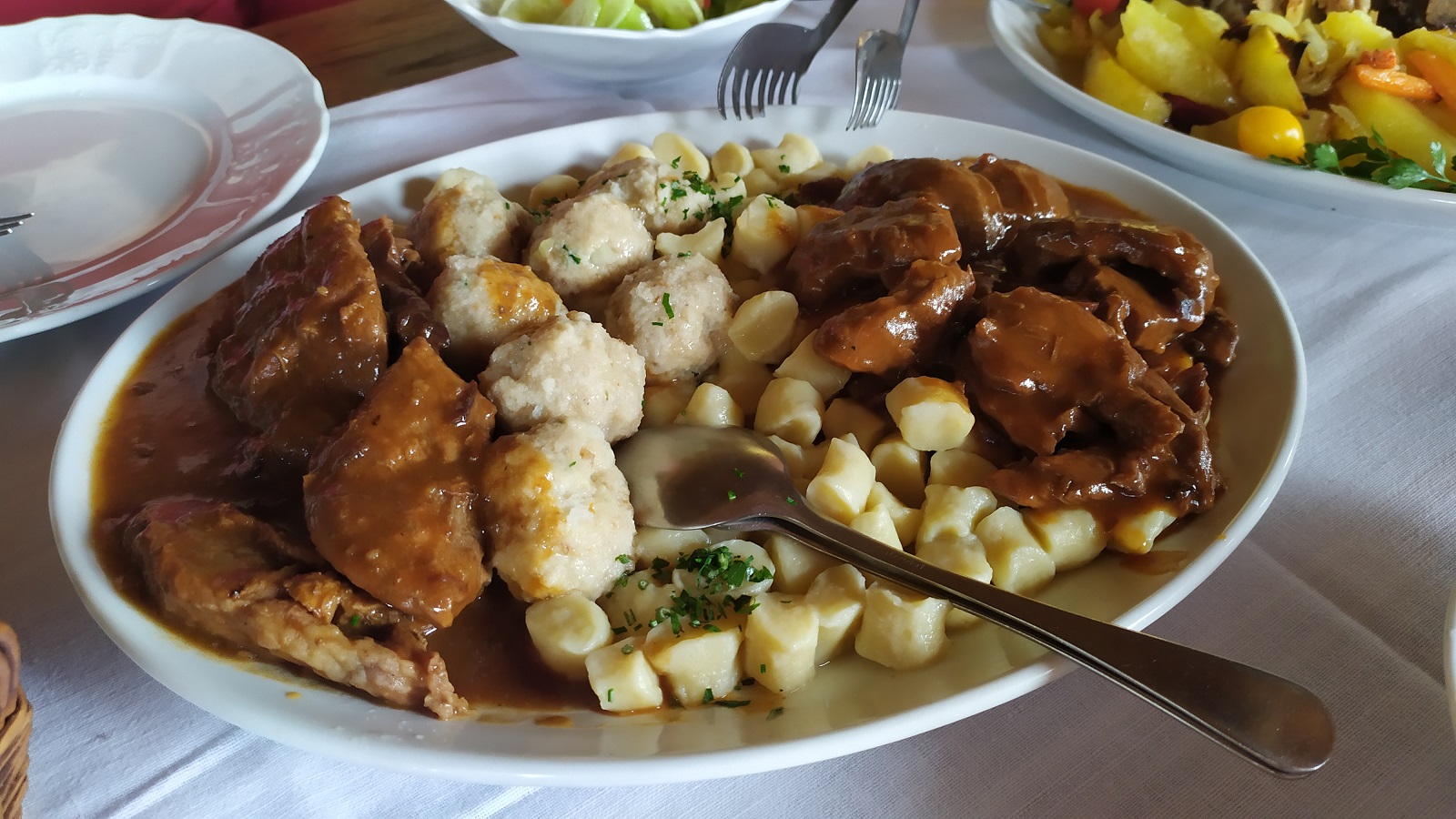
Deer in cranberry sauce and boar in the plum sauce, along with homemade dumplings and gnocchi / Donatella Pauković
The restaurant's wine offer includes excellent wines from the nearby Moslavina region, which is known for its Škrlet wine sort. In the Eco-ethno village Strug, Škrlet is an indispensable part of the menu.
The restaurant is quite large and it often hosts various celebrations, and even weddings, as the country landscape represents a beautiful setting for wedding photos.
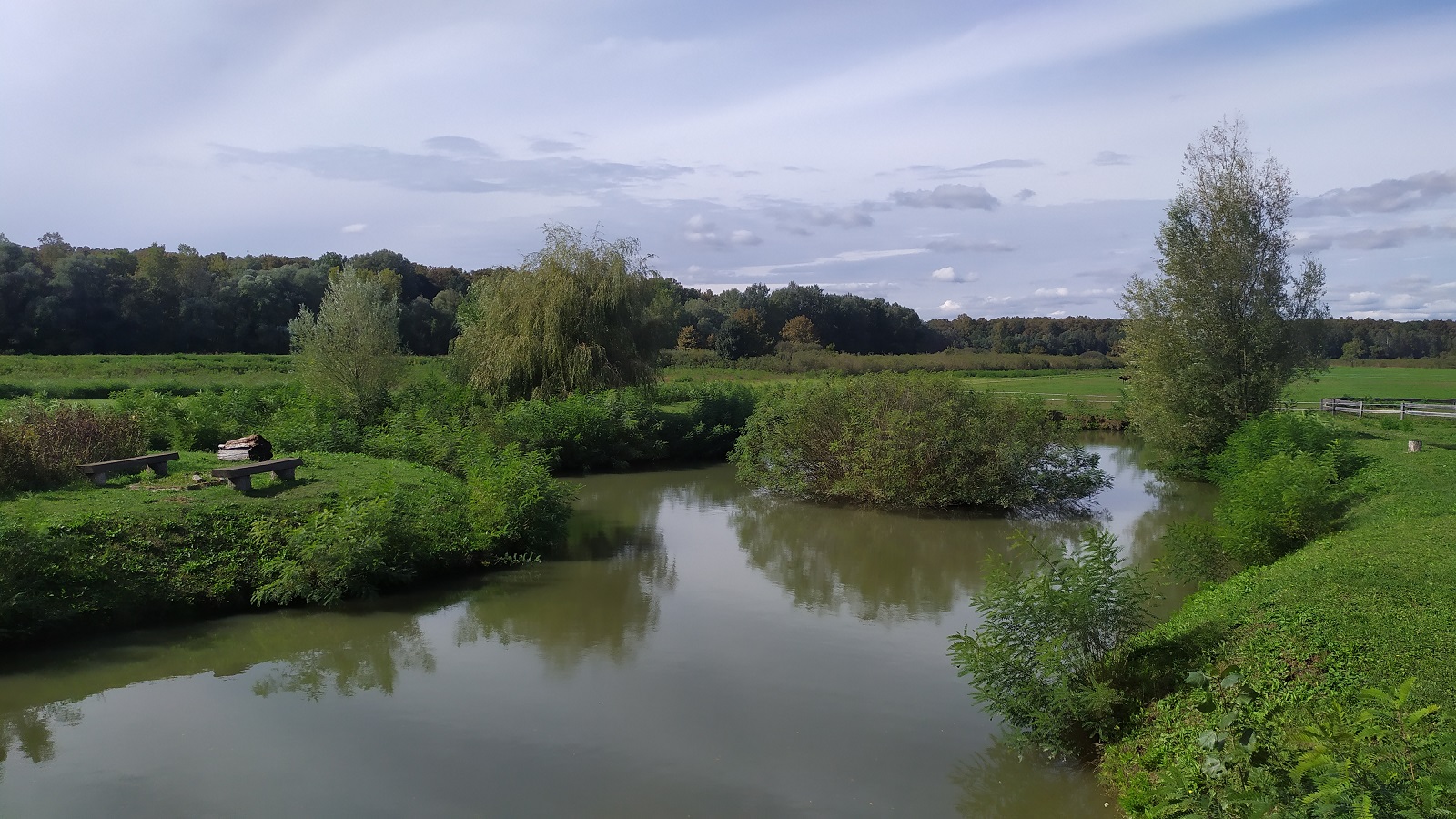
A view on the small lake from the restaurant / Donatella Pauković
Domestic animals' property
Also, the Eco-Ethno village Strug is located near the architectural heritage village Krapje, and not far away is the stork village of Čigoč, which we described in an article dedicated to Lonjsko Polje, so the visitors are offered plenty of other activities.
Visiting the Eco-ethno village Strug, one gets used to the presence of many domestic animals that enjoy grazing there. The sound (and the smell) of domestic animals such as chickens, roosters, ducks, geese, and rabbits surround the farm.
Poultry at the Eco-Ethno village Strug / Donatella Pauković
However, the main “stars“ of the Eco-ethno village Strug are unquestionably Posavina horses. Six of them live here and freely feed on the grass on pasture, while people only occasionally give them corn.
Some of them are retired racehorses. They are tame and lovely because they are used to people, especially children who visit the village as part of school trips. Until recently, there was also the possibility of horseback riding, but these activities were stopped due to the current pandemic.
But regardless, it is a real pleasure to just watch them through the large windows of the restaurant, and maybe approach them and tease them.
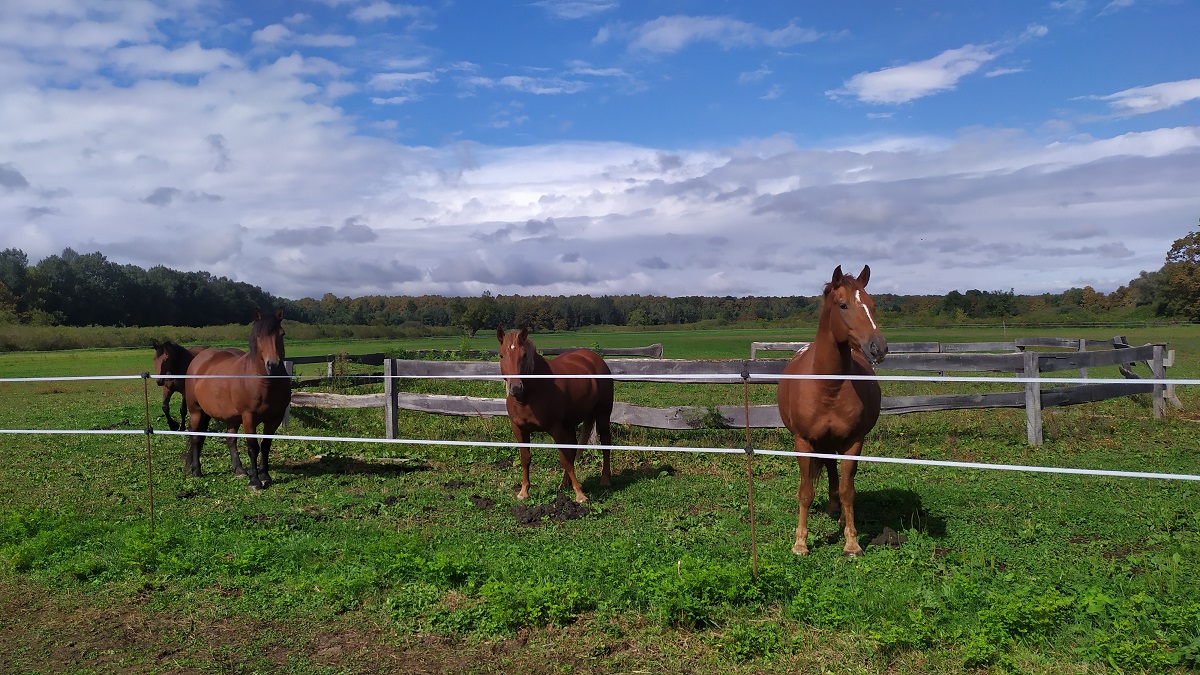
Posavina horses / Donatella Pauković
Posavina horse / Donatella Pauković
Whether you want to escape in nature or replace the usual environment with the rather unusual touch of the countryside where you don't have to think about anything, the Eco-ethno village Strug will not disappoint you.
For the latest travel info, bookmark our main travel info article, which is updated daily.
Read the Croatian Travel Update in your language - now available in 24 languages.
Join the Total Croatia Travel INFO Viber community.



